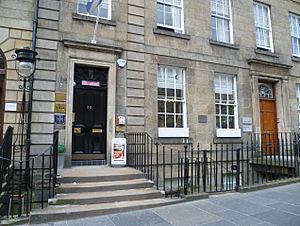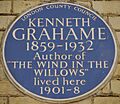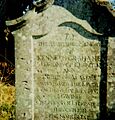Kenneth Grahame facts for kids
Quick facts for kids
Kenneth Grahame
|
|
|---|---|
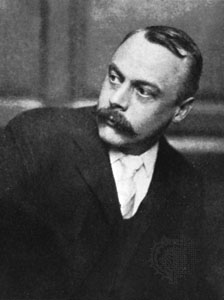
Kenneth Grahame in 1910
|
|
| Born | 8 March 1859 Edinburgh, Scotland, UK |
| Died | 6 July 1932 (aged 73) Pangbourne, Berkshire, England, UK |
| Occupation |
|
| Genre | Fiction |
| Notable works | The Wind in the Willows (1908) |
Kenneth Grahame (born March 8, 1859 – died July 6, 1932) was a Scottish writer. He is most famous for his book The Wind in the Willows (1908). This book is considered one of the greatest classics in children's literature.
He also wrote The Reluctant Dragon. Both of these books were later turned into plays and movies. Toad of Toad Hall by A. A. Milne was one of the first plays. The Disney films The Adventures of Ichabod and Mr. Toad and The Reluctant Dragon are other well-known adaptations.
Contents
About Kenneth Grahame's Life
His Early Years
Kenneth Grahame was born in Edinburgh, Scotland, on March 8, 1859. When he was just over a year old, his father, who was a lawyer, got a new job. This job was in Argyllshire at Inveraray, near Loch Fyne.
Kenneth loved the sea and was very happy living there. But when he was five years old, his mother passed away from an illness. His father, who was struggling with alcohol, decided to send Kenneth and his siblings to live with their grandmother. So, Kenneth, his brother Willie, his sister Helen, and baby Roland moved to Granny Ingles's home. This home was in Cookham Dean, a village in Berkshire, England.
The children lived in a large, old house called The Mount. It had big grounds and was near a river. Their uncle, David Ingles, taught them about the riverside and how to go boating. Many people believe that this area, especially Quarry Wood and the River Thames, inspired the setting for The Wind in the Willows.
Grahame was a very good student at St Edward's School, Oxford. When he first started there, there were no organized sports. This meant the boys were free to explore the old city and the areas around it.
His Career Path
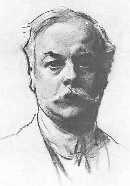
Kenneth Grahame really wanted to go to Oxford University. However, his guardian said he couldn't go because it was too expensive. Instead, he started working at the Bank of England in 1879.
He worked his way up in the bank. He eventually became the Secretary of the bank. He retired in 1908 because of health issues. His health problems might have been made worse by an incident at the bank in 1903. During this event, someone shot at Grahame three times, but all the shots missed him.
Another story says he had a disagreement with Walter Cunliffe, a director at the bank. Grahame was heard saying that Cunliffe was "no gentleman." His retirement was officially for health reasons, but some believe it was due to this disagreement. He was given a yearly pension after he retired.
Marriage and Family Life
Grahame married Elspeth Thomson in 1899. They had only one child, a boy named Alastair. They nicknamed him "Mouse." Alastair was blind in one eye and had many health problems throughout his short life.
After Grahame retired, his family moved back to Cookham. This was the place where he grew up. They lived at a house called Mayfield. It is now a school. It was here that Grahame told Alastair bedtime stories. These stories later became The Wind in the Willows.
Sadly, Alastair passed away tragically on a railway track. He was an undergraduate student at Oxford University. This happened five days before his 20th birthday in May 1920. To respect Grahame, Alastair's death was recorded as an accident.
His Passing
Kenneth Grahame died in Pangbourne, Berkshire, in 1932. He is buried in Holywell Cemetery, Oxford. Grahame's cousin, Anthony Hope, who was also a successful writer, wrote a special message for his tombstone. It says that Grahame left childhood and literature "more blest for all time."
Kenneth Grahame's Writing
When Kenneth Grahame was in his twenties, he started publishing short stories. These stories appeared in London magazines like the St. James Gazette. Some of these stories were put together into a book called Pagan Papers in 1893. Two years later, he published The Golden Age.
These books were followed by Dream Days in 1898. This book included the story The Reluctant Dragon.
There was a ten-year break before Grahame published his most famous book, The Wind in the Willows. During that time, Grahame became a father. He saw some of his son Alastair's wild and strong-willed nature. He used these traits to create the character of the proud Mr. Toad. Mr. Toad is one of the four main characters in the book.
The character known as Ratty was inspired by his good friend, Sir Arthur Quiller-Couch. Grahame even mentioned this in a signed copy of the book he gave to Quiller-Couch's daughter. Even though The Wind in the Willows was a huge success, Grahame never wrote a sequel.
The book is still enjoyed by both adults and children today. It has been made into many movies and TV shows. Mr. Toad remains one of the most famous and loved characters in children's books. In 1929, A. A. Milne wrote a play called Toad of Toad Hall. This play was based on parts of The Wind in the Willows. It won an award in 1958. In the 1990s, William Horwood wrote a series of sequel books.
His Published Works
- Pagan Papers (1893)
- The Golden Age (1895)
- Dream Days (1898), which includes "The Reluctant Dragon" (1898)
- The Headswoman (1898)
- The Wind in the Willows (1908), with pictures by Ernest H. Shepard
- Bertie's Escapade (1949), with pictures by Ernest H. Shepard
Images for kids
See also
 In Spanish: Kenneth Grahame para niños
In Spanish: Kenneth Grahame para niños


